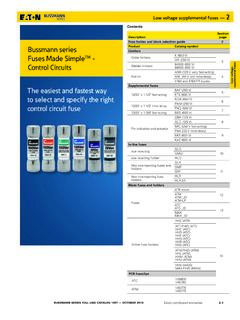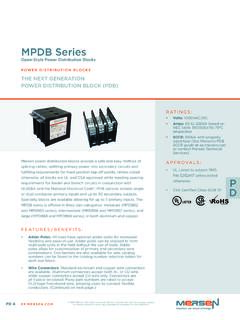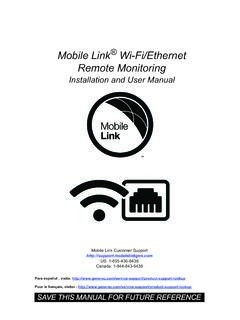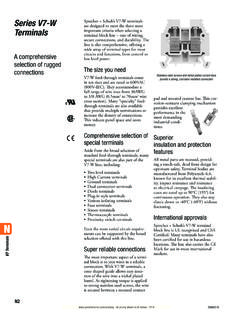Transcription of arXiv:1810.04805v2 [cs.CL] 24 May 2019
1 BERT: Pre-training of Deep Bidirectional Transformers forLanguage UnderstandingJacob Devlin Ming-Wei Chang Kenton Lee Kristina ToutanovaGoogle AI introduce a new language representa-tion model calledBERT, which stands forBidirectionalEncoderRepresentations fromTransformers. Unlike recent language repre-sentation models (Peters et al., 2018a; Rad-ford et al., 2018), BERT is designed to pre-train deep bidirectional representations fromunlabeled text by jointly conditioning on bothleft and right context in all layers. As a re-sult, the pre-trained BERT model can be fine-tuned with just one additional output layerto create state-of-the-art models for a widerange of tasks, such as question answering andlanguage inference, without substantial task-specific architecture is conceptually simple and empiricallypowerful.
2 It obtains new state-of-the-art re-sults on eleven natural language processingtasks, including pushing the GLUE score ( point absolute improvement),MultiNLI accuracy to ( absoluteimprovement), SQuAD question answer-ing Test F1 to ( point absolute im-provement) and SQuAD Test F1 to ( point absolute improvement).1 IntroductionLanguage model pre-training has been shown tobe effective for improving many natural languageprocessing tasks (Dai and Le, 2015; Peters et al.,2018a; Radford et al., 2018; Howard and Ruder,2018). These include sentence-level tasks such asnatural language inference (Bowman et al., 2015;Williams et al.)
3 , 2018) and paraphrasing (Dolanand Brockett, 2005), which aim to predict the re-lationships between sentences by analyzing themholistically, as well as token-level tasks such asnamed entity recognition and question answering,where models are required to produce fine-grainedoutput at the token level (Tjong Kim Sang andDe Meulder, 2003; Rajpurkar et al., 2016).There are two existing strategies for apply-ing pre-trained language representations to down-stream tasks:feature-basedandfine-tuning. Thefeature-based approach, such as ELMo (Peterset al., 2018a), uses task-specific architectures thatinclude the pre-trained representations as addi-tional features.
4 The fine-tuning approach, such asthe Generative Pre-trained Transformer (OpenAIGPT) (Radford et al., 2018), introduces minimaltask-specific parameters, and is trained on thedownstream tasks by simply fine-tuningallpre-trained parameters. The two approaches share thesame objective function during pre-training, wherethey use unidirectional language models to learngeneral language argue that current techniques restrict thepower of the pre-trained representations, espe-cially for the fine-tuning approaches. The ma-jor limitation is that standard language models areunidirectional, and this limits the choice of archi-tectures that can be used during pre-training.
5 Forexample, in OpenAI GPT, the authors use a left-to-right architecture, where every token can only at-tend to previous tokens in the self-attention layersof the Transformer (Vaswani et al., 2017). Such re-strictions are sub-optimal for sentence-level tasks,and could be very harmful when applying fine-tuning based approaches to token-level tasks suchas question answering, where it is crucial to incor-porate context from both this paper, we improve the fine-tuning basedapproaches by proposing BERT:BidirectionalEncoderRepresentations alleviates the previously mentioned unidi-rectionality constraint by using a masked lan-guage model (MLM) pre-training objective, in-spired by the Cloze task (Taylor, 1953).
6 Themasked language model randomly masks some ofthe tokens from the input, and the objective is topredict the original vocabulary id of the [ ] 24 May 2019word based only on its context. Unlike left-to-right language model pre-training, the MLM ob-jective enables the representation to fuse the leftand the right context, which allows us to pre-train a deep bidirectional Transformer. In addi-tion to the masked language model, we also usea next sentence prediction task that jointly pre-trains text-pair representations. The contributionsof our paper are as follows: We demonstrate the importance of bidirectionalpre-training for language representations.
7 Un-like Radford et al. (2018), which uses unidirec-tional language models for pre-training, BERT uses masked language models to enable pre-trained deep bidirectional representations. Thisis also in contrast to Peters et al. (2018a), whichuses a shallow concatenation of independentlytrained left-to-right and right-to-left LMs. We show that pre-trained representations reducethe need for many heavily-engineered task-specific architectures. BERT is the first fine-tuning based representation model that achievesstate-of-the-art performance on a large suiteof sentence-levelandtoken-level tasks, outper-forming many task-specific architectures. BERT advances the state of the art for elevenNLP code and pre-trained mod-els are available Related WorkThere is a long history of pre-training general lan-guage representations, and we briefly review themost widely-used approaches in this Unsupervised Feature-based ApproachesLearning widely applicable representations ofwords has been an active area of research fordecades, including non-neural (Brown et al.)
8 , 1992;Ando and Zhang, 2005; Blitzer et al., 2006) andneural (Mikolov et al., 2013; Pennington et al.,2014) word embeddingsare an integral part of modern NLP systems, of-fering significant improvements over embeddingslearned from scratch (Turian et al., 2010). To pre-train word embedding vectors, left-to-right lan-guage modeling objectives have been used (Mnihand Hinton, 2009), as well as objectives to dis-criminate correct from incorrect words in left andright context (Mikolov et al., 2013).These approaches have been generalized tocoarser granularities, such as sentence embed-dings (Kiros et al., 2015; Logeswaran and Lee,2018) or paragraph embeddings (Le and Mikolov,2014).
9 To train sentence representations, priorwork has used objectives to rank candidate nextsentences (Jernite et al., 2017; Logeswaran andLee, 2018), left-to-right generation of next sen-tence words given a representation of the previoussentence (Kiros et al., 2015), or denoising auto-encoder derived objectives (Hill et al., 2016).ELMo and its predecessor (Peters et al., 2017,2018a) generalize traditional word embedding re-search along a different dimension. They extractcontext-sensitivefeatures from a left-to-right and aright-to-left language model. The contextual rep-resentation of each token is the concatenation ofthe left-to-right and right-to-left integrating contextual word embeddingswith existing task-specific architectures, ELMoadvances the state of the art for several major NLPbenchmarks (Peters et al.)
10 , 2018a) including ques-tion answering (Rajpurkar et al., 2016), sentimentanalysis (Socher et al., 2013), and named entityrecognition (Tjong Kim Sang and De Meulder,2003). Melamud et al. (2016) proposed learningcontextual representations through a task to pre-dict a single word from both left and right contextusing LSTMs. Similar to ELMo, their model isfeature-based and not deeply bidirectional. Feduset al. (2018) shows that the cloze task can be usedto improve the robustness of text generation Unsupervised Fine-tuning ApproachesAs with the feature-based approaches, the firstworks in this direction only pre-trained word em-bedding parameters from unlabeled text (Col-lobert and Weston, 2008).
![arXiv:0706.3639v1 [cs.AI] 25 Jun 2007](/cache/preview/4/1/3/9/3/1/4/b/thumb-4139314b93ef86b7b4c2d05ebcc88e46.jpg)

![arXiv:1301.3781v3 [cs.CL] 7 Sep 2013](/cache/preview/4/d/5/0/4/3/4/0/thumb-4d504340120163c0bdf3f4678d8d217f.jpg)
![@google.com arXiv:1609.03499v2 [cs.SD] 19 Sep 2016](/cache/preview/c/3/4/9/4/6/9/b/thumb-c349469b499107d21e221f2ac908f8b2.jpg)












